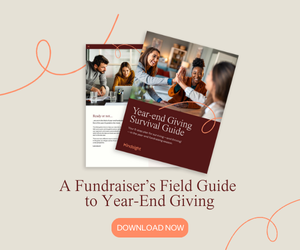Fundraising Tools: Major Gift Metrics Shouldn’t Focus on Visits— A Pandemic Epiphany

A number of articles have been written on major gift officer metrics over the years, and I want to add my thoughts because the pandemic helped me rethink my approach to what I measure and how I use it.
In March of 2020, we all had to rethink our approach to fundraising since what we thought as the most critical part of the work, a face-to-face meeting with a donor, could no longer occur. At least, we thought, this would be temporary, then things would straighten out and we could once again travel to meet donors. The pause in travel allowed space to step back and re-examine the old way of thinking about many things, including metrics and the heavy reliance on visits. With visits temporarily taken out of the metrics equation, the spotlight was now on outcomes and results.
And guess what? Donor conversations still happened, proposals were submitted, asks were made, gifts were closed, and goals were met or exceeded.
Then I had an epiphany. This way of tracking and measuring major gift work made more sense so I made it permanent. In doing so, I avoided the existential crisis that plagued many nonprofit major gift directors when they asked now, “What constitutes a visit?” This question dominated chat rooms and listservs as major gift directors struggled to redefine a visit in the time of COVID-19.
Implementing Outcomes-Based Metrics
Yes, I’ve heard the argument that activity drives productivity, and that is true but only to an extent. When looking at metrics reports, it always seems that whatever the specific criteria being measured, meetings are listed first, or on the left side of the report, and as one reads across the report, left to right, the criteria shifts to dollar-focused measurements. I understand why that has been the norm because there is a logical sequence of activity. First you meet the prospect, establish a relationship and understand the type of impact they want to achieve with their philanthropy, then submit a proposal or make “the ask,” follow-up, close the gift, steward, and repeat.
In an outcomes-based metrics report, the sequence is either flipped, with the desired outcomes—proposal submitted, dollar goal, dollars raised, yield rate—listed first then visits, or else visits are eliminated as a criteria on the report altogether. It simplifies your metrics report and zeroes in on the actions that create true movement. This also clearly communicates to major gift officers the steps they should be focused on. All the other work that leads to these outcomes can be tracked in other ways, and should be, but don’t belong in a metrics report anymore. There are a number of reporting tools that works with various customer relationship management (CRM) programs that allow you to do this. Things you can track include number of visits (which should include virtual meetings and substantial phone calls or email exchanges), the percent of the portfolio in the moves management continuum (qualification, cultivation, strategy, solicitation, negotiation, stewardship) and last date of contact. In other words, limit the number of metrics you track to reflect your ultimate goal.
 Since implementing outcomes-based metrics two years ago, St. Lawrence University has seen a 74% increase in the number of funded proposals, a 36% increase in dollars raised from proposals and a 73% in yield rate from accepted proposals. In 2021 alone, over 23,000 overall donor contacts (in-person, virtual, phone, mail) were made by major gift officers, a 34.5% increase over 2020. (In full disclosure, 2021 was the final year of a campaign, so this year being post-campaign will look different.)
Since implementing outcomes-based metrics two years ago, St. Lawrence University has seen a 74% increase in the number of funded proposals, a 36% increase in dollars raised from proposals and a 73% in yield rate from accepted proposals. In 2021 alone, over 23,000 overall donor contacts (in-person, virtual, phone, mail) were made by major gift officers, a 34.5% increase over 2020. (In full disclosure, 2021 was the final year of a campaign, so this year being post-campaign will look different.)
If you think what I’m recommending is drastic, consider Notre Dame. They measure just two metrics–the number of proposals presented and the amount of dollars raised. That’s it. The rest they can track and measure in other ways if needed. Their fundraising results in recent years proves that simplifying major gifts metrics, and focusing on the most important actions needed to secure a gift, works. According to the Indianapolis Business Journal (Jan. 21, 2022), Notre Dame has landed eight donations of $10 million or more “worth a total of at least $158 million” since 2018.
However, some of the changes won’t be reflected in dollars.
Moving away from an activity-based metrics report to a productivity-based one empowers gift officers. They know the donor best and what type of outreach is needed to keep a gift conversation moving along. Morale among major gift officers will increase. By instilling an “eye on the prize” work ethic, a stronger sense of team comradery should emerge with everyone focused on working toward the same goal. You’ll free gift officers to be more donor-centric in their relationship with their prospects. They won’t have to be so hyper-focused on securing face-to-face visits and will have more time to analyze strategic ways in which to engage donors and move closer to a making a major gift.
Outcomes-based metrics demonstrates trust in the gift officer. Trusted gift officers are happy gift officers. Happy gift officers mean happy donors. Happy donors translate into increased giving.
By adopting a productivity-over-activity model of measuring frontline fundraisers, steps that create real movement (there’s a reason we call it “moves management!”) are emphasized. We all know of gift officers who consistently meet or exceed their visit goals but don’t meet or exceed their dollar goals. Yes, everyone can have a dry spell and qualifying and stewarding donors is important. But let’s face it, we are a dollar-driven industry. If you employ metrics that focus on productivity, you are communicating and emphasizing to gift officers that these are the actions that are essential to successfully closing major gifts. If you focus on visits, you will get visits.
Not that visits are unimportant. Far from it. Most of the “magic” happens on the road. But, the pandemic has forced us to reevaluate what is the best way to make strong and lasting relationships with donors. It no longer matters where or how a donor meeting occurs but that it occurs.
“… Recognizing that making a move with a donor has nothing to do with whether you are in person, but rather did the person get closer to a gift, to the organization, etc. We are closing one of the top five years in fundraising at our institution and less than 5% of our visits were in person.” (Gift/alumni relations officer)*
It also takes time to shift thinking and see progress. Be patient but persistent in talking to leadership about emphasizing productivity and results over activity and input. Approach this much in the way you would talk to a donor. Be prepared, do research, provide data and share stories to demonstrate impact. Understand that measuring the number of donor visits has been the traditional way in which to measure good gift officers’ work for over 30 years and that change may not come quickly.
When I shared with my team that for fiscal year 2021 visits would not be reflected on the metrics report, the news was greeted with enthusiasm. I learned that they were stressed about whether donors would be open to virtual meetings. They were worried about making an ask in a virtual meeting and how that would be received by the donor. Would it seem just as authentic and genuine as an in-person ask?
On the other hand, some gift officers had donors who were more comfortable having a gift conversation via text. Now their worries were gone. What counted as a visit and what didn’t no longer plagued my team. They understood that all outreach was still tracked, and we could still look at that information, when necessary. Now, in a time of increased stress and worry, they had one less thing to worry about and could concentrate on the steps needed to bring a donor to make a major gift.
How to Communicate Major Gift Metrics
Just as important as what is measured is how those measurements are discussed and communicated. Talking openly and honestly about metrics is important. Be vocal about metrics being flexible and reassess your metrics every year. Metrics should be fluid and evolve over time.
There are many variables to consider in creating major gift metrics, such as gift officer experience (novice vs. mature), responsibilities (management, overseeing programs, etc.) and campaign stage. Share with your team how you “read” the monthly metrics report and what you take away from it. Allow them access to the other tracking and measuring reports if you’re able. Listen to what they have to say. You may be surprised that they look at metrics in a different way than you and have good suggestions on what they think should be measured. I’ve added a few metrics over the years as a result of listening to my major gift officers, including Gateway Gifts and Annual Fund Dollars. Gateway Gifts are what we call outright gifts between $25,000 and $99,999 that are a leading indicator that a donor is moving toward a major gift commitment. I’m glad we did this, but as we moved closer to the end of the campaign, I eliminated that metric as our focus shifted to moving those donors to commit to a major gift.
In short, the pandemic forced those of us in major gift fundraising to think differently, and some, myself included, feel the paradigm shift is here to stay. I’m grateful for my epiphany and have become a convert to outcomes-based metrics. I hope this article has convinced you of the same or at least sparked your curiosity.
*Washburn & McGoldrick, LLC 2021 Client Survey.


 Terri Selby is the executive director of major and planned gifts at St. Lawrence University. She has worked for more than 20 years in higher education/nonprofit fundraising, with experience leading annual, parent, major and planned giving teams. Her relationship-building with donors, volunteers and staff is informed by an early career in sales and a background in communications. When not diving deep into fundraising metrics, Terri can be found on her Nordic skate skis, kayaking, walking and reading real hard cover books.
Terri Selby is the executive director of major and planned gifts at St. Lawrence University. She has worked for more than 20 years in higher education/nonprofit fundraising, with experience leading annual, parent, major and planned giving teams. Her relationship-building with donors, volunteers and staff is informed by an early career in sales and a background in communications. When not diving deep into fundraising metrics, Terri can be found on her Nordic skate skis, kayaking, walking and reading real hard cover books.
